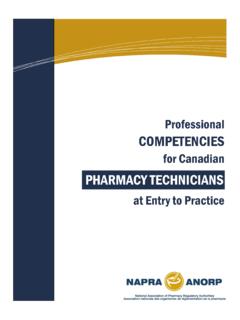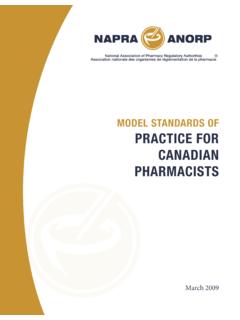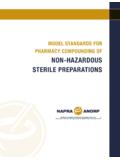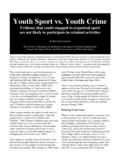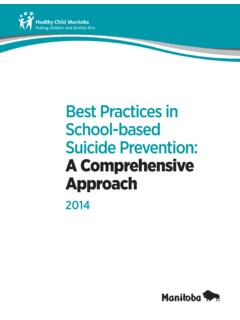Transcription of Professional Competencies for Canadian …
1 Professional Competencies for Canadian pharmacists at Entry to Practice Second revision March 2007 Professional Competencies for Canadian pharmacists at Entry to Practice 2 National Association of Pharmacy Regulatory Authorities, 2007. All rights reserved. No part of this document may be reproduced in any form by any photographic, electronic, mechanical or other means, or used in any information storage and retrieval system, without the written permission of the author. The National Association of Pharmacy Regulatory Authorities (NAPRA), 220 Laurier Avenue West, Suite 750, Ottawa, ON K1P 5Z9 (613) 569-9658 fax (613) 569-9659 e-mail: Professional Competencies for Canadian pharmacists at Entry to Practice 3 Background NAPRA was formed in February 1995 as an umbrella organization of canada s provincial pharmacy regulatory bodies.
2 The mission of our association is to facilitate the activities of provincial pharmacy regulatory authorities in their service of public interest. This is accomplished by: representing the interests of the member organizations; serving as a national resource centre; and promoting the harmonization of legislation and standards These national Competencies were originally developed in 1997 in response to the federal government s Agreement on Internal Trade (AIT) which came into effect in 1995. Chapter Seven of the AIT, the Labour Mobility Chapter, specifies that any worker qualified for an occupation in one province or territory should be granted access to employment in that occupation in any other province or territory in canada .
3 One mechanism to facilitate this is through the development of a mutual recognition agreement, especially if there is a high degree of commonality throughout the profession. These national Competencies are reflective of that commonality, and form the basis of a National Model Licensing Program which describes entry to practice requirements for initial licensing of pharmacists in jurisdictions that are signatories to the mutual recognition agreement. These Competencies were revised by representatives of the pharmacy profession from all jurisdictions across canada (except Yukon and Nunavut) during a workshop hosted by NAPRA in January 2007.
4 In addition, they were reviewed by external stakeholders prior to being finalized and adopted by the NAPRA Board of Directors. NAPRA thanks both workshop participants and stakeholders for their time and efforts in the revision of these Competencies . In addition, many thanks to Kelly Piasentin of Assessment Strategies Inc. of Ottawa for facilitating this process. Professional Competencies for Canadian pharmacists at Entry to Practice 4 Contents Page Background 3 Competencies of Entry Level pharmacists 5 Competency Categories 6 Competency #1: Patient Care 7 Competency #2: Professional Collaboration and Team Work 10 Competency #3: Ethical, Legal and Professional Responsibilities 11 Competency #4.
5 Drug, Therapeutic and Practice Information 12 Competency #5: Communication and Education 13 Competency #6: Drug Distribution 14 Competency #7: Management Knowledge and Skills 15 Glossary of Terms Workshop Participants 1618 Professional Competencies for Canadian pharmacists at Entry to Practice 5 Competencies of Entry Level pharmacists This document outlines the competencies1 required of pharmacists at the point of licensure in canada , for the benefit of the Canadian public. The Competencies require as a minimum prerequisite the completion of an accredited2 baccalaureate in pharmacy degree program.
6 It is recognized that the knowledge, skills and attitudes gained in the completion of an accredited program will provide the foundation for all Competencies . Through these Competencies , pharmacists assist individuals and groups to achieve desired health outcomes by providing current, rational, safe and cost-effective pharmaceutical information, products and services. In developing the list of Competencies for pharmacists , the following assumptions were made: The Practice Environment: pharmacists work in a wide variety of practice environments ( , community pharmacy, hospital/institutional pharmacy, education, research, consulting, family health centres, etc.)
7 The Patient3: Refers to any person or authorized agent to whom a pharmacist provides a service that is within the practice of pharmacy. The agent refers to a family member, caregiver, or another person who has a close personal relationship with the patient. The Health Care Professional : Refers to professionals within the patient s circle of care4. The Pharmacist: Is a registered/licensed pharmacist who: - practices in accordance with Professional registration and licensure, and Professional standards within his/her jurisdiction. - possesses both broad-based and pharmacy specific knowledge.
8 - uses critical-thinking, problem-solving and decision-making skills appropriate to the pharmacist role. - mentors pharmacists , pharmacy students or interns, pharmacy technicians and others. - takes responsibility for his/her own continuing Professional development5 and commits to life-long learning. 1 See glossary 2 See glossary 3 In this document, the terms patient and client are synonymous. 4 See glossary 5 See glossary Professional Competencies for Canadian pharmacists at Entry to Practice 6 Competency Categories Patient Care pharmacists , in partnership with patients and other health care professionals, use their unique knowledge and skills to meet patients drug and health related needs and to achieve optimal patient outcomes and patient safety.
9 Professional Collaboration and Team Work pharmacists work in collaboration with other health care professionals to optimize patient safety and improve health outcomes. Ethical, Legal and Professional Responsibilities pharmacists practise within legal requirements, demonstrate Professional integrity and act to uphold Professional standards of practice and codes of ethics. Drug, Therapeutic and Practice Information pharmacists assume responsibility for accessing, retrieving, evaluating and exchanging relevant information to ensure safe and effective patient care.
10 Communication and Education pharmacists communicate with and provide education to groups and individuals in order to promote and support optimal patient care and well-being. Drug Distribution pharmacists manage the drug distribution system to ensure the safety, accuracy and quality of supplied products. Understanding Management Principles pharmacists apply knowledge, principles and skills of management with the goal of optimizing patient care and inter- Professional relationships. Professional Competencies for Canadian pharmacists at Entry to Practice 7 Competency #1: Patient Care Competency Unit6 Competency Elements7: Develop a trusting Professional relationship with the patient where both parties are interacting in a way where the obligations, expected benefits, and consequences are clearly defined.
